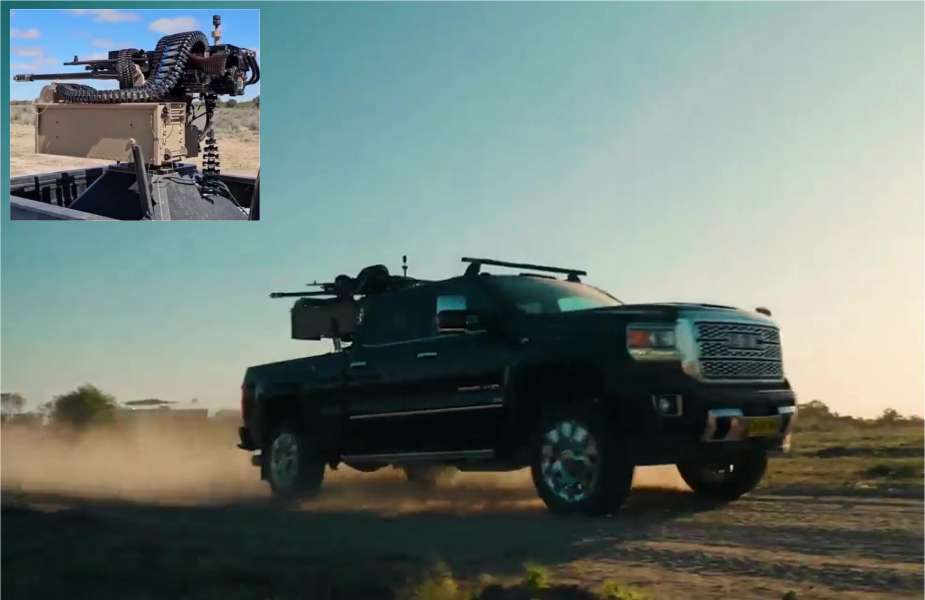Australian EOS Slinger anti-drone system ready to destroy Russian drones in Ukraine
According to ABC Australia on October 2, 2023, Electro Optic Systems (EOS), an Australian defense company, has recently completed the production of its Slinger anti-drone systems intended for use in Ukraine. As previously reported on September 8, 2023, EOS is poised to supply Ukraine with a total of 160 Slinger anti-drone systems. Among these, 110 units are designated for mounting on M113 Armored Personnel Carriers (APCs), while the remaining 50 will be installed on Bushmaster APCs by the Ukrainian firm Praktyka.
Follow Army Recognition on Google News at this link

Australian EOS Slinger anti-drone system ready to destroy Russian drones in Ukraine (Picture source: EOS and Twitter)
According to the article, ten Slinger systems are due to be delivered to Ukraine by the end of the year as part of a US military aid program. However, the article does not specify whether these ten systems are part of the 160 announced or whether there will be ten additional units. The Slinger anti-drone system draws inspiration from historical slinger soldiers known for their precise long-range attacks employing lightweight and cost-effective weaponry as the primary objective of the Slinger system is to launch "hard kill" strikes against drones efficiently.
The Slinger system, typically mounted on a 2017 GMC Denali 2500HD, serves as a lightweight and adaptable weapon platform, weighing less than 400 kg. It offers full stabilization for on-the-move operations and features a fourth-axis sighting system with a sensor unit capable of independent movement in both elevation and azimuth. The system is equipped with a Bushmaster M230LF 30x113mm cannon, with a firing capacity of 200 rounds per minute, in addition to a 7.62mm MAG58 machine gun capable of a firing rate ranging from 650 to 1,000 rounds per minute.
One key aspect of the Slinger system is its cost-effectiveness. In comparison to the Iranian Shahed drone, employed by Russia in Ukraine and costing approximately $31,000 each, the missiles required to intercept these drones can cost significantly more. This cost differential has made conventional missile-based defenses less economically viable for many nations.
EOS has employed advanced technology to create a user-friendly system that does not require extensive technical expertise. During testing, EOS engineer Charlotte Capper demonstrated its operation by utilizing a joystick to track a drone on a targeting screen, ensuring ease of use for operators.
Ukraine's ambassador to Australia, Vasyl Myroshnychenko, witnessed the effectiveness of Slinger during testing and highlighted the significance of cost-effective defense solutions, particularly in light of ongoing drone and missile attacks in Ukrainian cities. Some missiles used to intercept $20,000 drones cost millions, while the Slinger system is priced at less than $1.55 million per unit, with a cost per engagement ranging from $155 to $1,550.
Approximately 85% of the components used in the Slinger system are sourced from Australian suppliers, with key components like cameras, lasers, and gimbals assembled in locations such as Queanbeyan and the Australian Capital Territory. EOS's expertise in space technology heritage enables it to track objects as small as a 10-cent piece orbiting at altitudes of up to 36,000 km, a capability that is essential for effectively targeting small, fast-moving drones.
On September 7, 2023, EOS conducted a successful test of the Slinger system at the Klondyke Range Complex in western New South Wales, Australia. During the test, the Slinger system effectively engaged moving drones from a mobile platform, demonstrating its accuracy in neutralizing drones at distances of up to 500 meters using machine guns.
In terms of specifications, the system maintains a height of 90 cm above the roof and a total weight, including the weapon and maximum ammunition, of 355 kg above the roof. Additionally, there is a control group weighing 21 kg. It can carry a maximum ammunition load of 150 rounds and possesses an elevation range of 70° and a depression range of -10°, enabling it to engage targets from various angles.
The Slinger employs lightweight 30mm Proximity Sensing Ammunition equipped with a radio frequency proximity fuze and a high explosive fragmentation round. The system also incorporates an Echodyne ultra-low size, weight, and power (SWaP) 4D targeting radar featuring active beam steering Electronic Scanning Antenna (ESA) technology and a wind sensor to enhance accuracy.
The system offers firing stability, with deviation measuring less than 1 milliradian (mrad), ensuring precise targeting. Its sensor unit includes both a day camera and a thermal imager, delivering detection, recognition, and identification capabilities for drones. These sensors have detection ranges, with the day camera reaching over 12,000 m and the thermal imager extending to over 13,700 m.
An integral component of the Slinger system is the FN MAG, also known as the MAG58, a 7.62mm general-purpose machine gun known for its versatility and reliability, with a cyclic rate of fire ranging from 650 to 1,000 rounds per minute. Its adaptability extends to ammunition compatibility, facilitating the use of 7.62x51mm NATO rounds with both disintegrating and non-disintegrating links. FN Herstal provides various ammunition types, including ball, tracer, armor-piercing, and blank rounds. The machine gun's features, such as a folding bipod, ergonomic stock, and adjustable gas regulator, enhance its usability in diverse combat scenarios. Furthermore, the option for remote operation through weapon stations makes it a practical choice for armed forces worldwide.





























